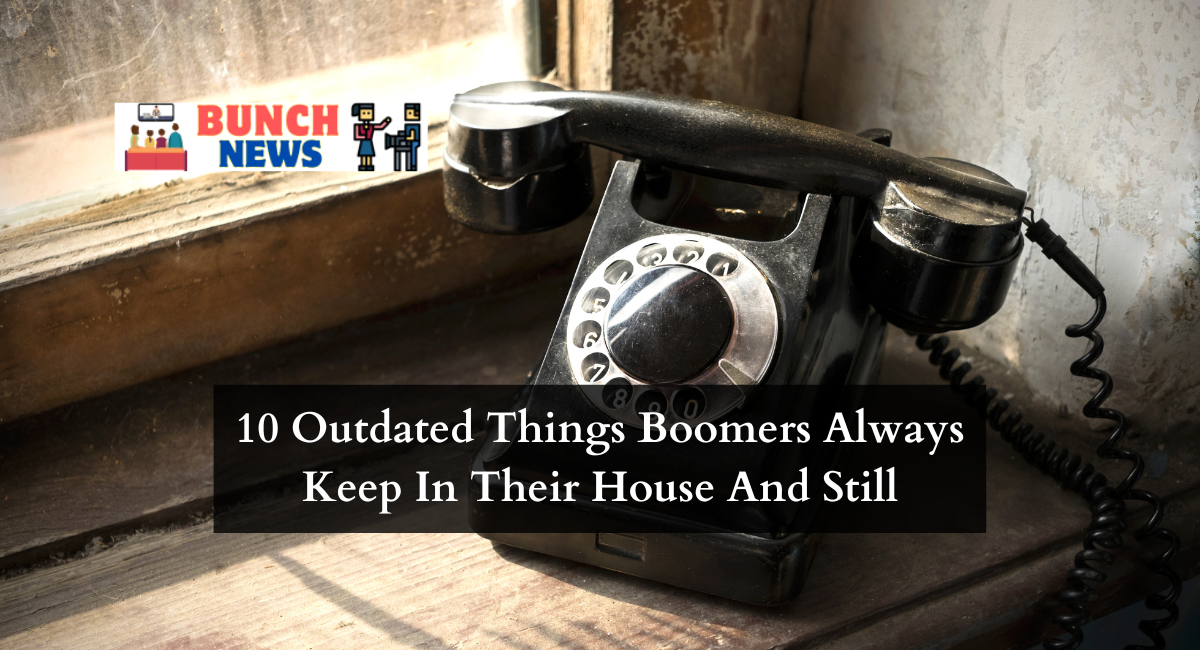Throughout their lifetimes, baby boomers, who were born between 1946 and 1964, have observed profound technological and societal transformations. However, upon entering the residences of particular baby boomers, one may encounter a delightful fusion of sentimentality and a steadfast refusal to part with specific items that have come to symbolize their generation. This article examines ten antiquated items that a significant number of baby boomers continue to possess within their residences, delving into whether this practice is motivated by nostalgia or serves as evidence of the enduring utility of these artifacts.
10 Outdated Things Boomers Always Keep In Their House And Still
Over time, successive generations frequently cling to particular inclinations and possessions that evoke memories from their adolescence. This blog will examine ten antiquated items that Baby Boomers continue to retain and utilize in their homes even though the world has changed rapidly regarding technology and lifestyles.
1. Landline Telephones
Amidst the dynamic and constantly progressing technological environment, landline telephones in specific households, especially those of the baby boomer generation, might appear to be an endearing relic of the past. In contrast to the prevalence of smartphones and mobile devices in modern communication, landline telephones serve as a sentimental anchor, frequently linked to an epoch characterized by dependability and uncomplicated design.
Why They’re Kept:
- Reliability and Familiarity: The continued use of landline telephones by baby boomers can be attributed, in large part, to the comfort and perceived dependability they provide. Many individuals associate these phones with a bygone era of communication that was simple and unencumbered by the intricacies of the digital age.
- Emergency preparedness: Certain individuals, particularly those residing in regions susceptible to natural calamities, perceive landlines as a dependable mode of communication in times of crisis. Because the telephone company powers them, landlines frequently continue to function even when other modes of communication fail.
2. Cassette And VHS Tapes
Amidst an electronic age dominated by streaming platforms, cloud-based entertainment, and high-definition downloads, cassette tapes and VHS tapes in specific households (especially those belonging to baby boomers) elicit nostalgia. It transports one back to the heyday of analog entertainment. In this investigation, we shall decipher the magnetic tape and examine the reasons behind the baby boomers’ continued possession of these artifacts from earlier periods.
Why They’re Kept:
- Sentimental Value: sentimental Value Frequently, cassette and VHS recordings contain sentimental Value. Numerous baby boomers possess curated assortments of mixtapes that comprise songs of particular taste or shelves embellished with films that encapsulate instances from their childhood.
- Personalized Content: An example of customized content could be observed in constructing a mixtape or capturing a preferred television program on a VHS tape. Every recording narrates a distinct story, mirroring its creator’s personal preferences and recollections.
3. Encyclopedias And Reference Books:
The enduring Value of physical tomes such as encyclopedias and reference volumes in specific households, especially those of baby boomers, is called into question in an era where information is readily accessible through a simple internet search. Let’s investigate why baby boomers continue to maintain these knowledge repositories in the digital age.
Why They’re Kept:
- A Symbol of Learning: An Invocation of Knowledge: Throughout history, encyclopedias and reference volumes have symbolized knowledge acquisition and inquisitiveness. However, Baby Boomers may still emphasize possessing a physical resource that represents their dedication to learning and insatiable curiosity.
- Aesthetic Appeal: Some baby boomers may find aesthetic appeal in arranging a collection of authoritative reference books or a meticulously organized set of encyclopedias displayed on a shelf. Observing these volumes may elicit feelings of organization and intellectual refinement.
4. Wall-Mounted Rotary Phones
In an age when dialing a phone required a physical connection and the rhythmic turn of a dial, the presence of wall-mounted rotary phones in specific households, especially those of baby boomers, is reminiscent of a time when streamlined cordless phones and smartphones predominated in the realm of contemporary communication. This analysis will delve into why baby boomers continue to display these rotary artifacts on their walls, as well as how they serve as a link between the past and the present.
Why They’re Kept:
- Aesthetic Charm: Aesthetic Appeal: Wall-mounted rotary phones resonate with baby boomers due to their vintage aesthetic appeal. Anger is evoked by the rotary dial, the robust construction, and the distinctive ring, all of which are reminiscent of a time when communication was more intentional and physical.
- Décor and Design Element: Certain baby boomers perceive these phones not merely as means of communication but also as design elements that augment the overall ambiance of a space. The nostalgic appeal that rotary phones evoke infuses interior design with personality.
5. Dial-Up Modems
Amidst the current digital communication landscape, dominated by high-speed broadband and fiber-optic connections, specific households, especially those of the baby boomer generation, continue to utilize dial-up modems as a sentimental homage to bygone eras. This analysis will examine the reasons behind the desire of baby boomers to retain these antiquated internet relics and how the recognizable dial-up tones convey them to a bygone era.
Why They’re Kept:
- Auditory Nostalgia: For baby boomers, the dial-up tones, which consist of a symphony of sounds and screeches, evoke a sense of nostalgia. Beyond serving as a connection indicator, the sound evokes memories of the eagerness and perseverance that characterized the nascent stages of internet connectivity.
- Historical Technological Artifact: Certain members of the baby boomer generation consider dial-up modems to be technological artifacts of the past, symbolizing the earliest days of pervasive internet access. The tangible existence of a modem provides an enduring connection to the nascent and captivating era of the internet.
6. China Cabinets And Formal Dining Rooms
During a time when open-concept living areas and informal dining have gained widespread acceptance, specific households (especially those belonging to the baby boomer generation) exhibit formal dining rooms and china cabinets as a demonstration of sophistication and a dedication to upholding conventional dining practices. This analysis will explore why baby boomers adhere to these aspects of sophisticated living and examine their adeptness at managing the intricate equilibrium between formality and contemporary informality.
Why They’re Kept:
- Symbol of Elegance: A Representation of Elegance: China cabinets and formal dining rooms symbolize sophistication and elegance. Having been raised with these elements, baby boomers might perceive them as valuable spaces and embodiments of an affluent way of life.
- Sentimental Value: porcelain cabinets serve as repositories for cherished family heirlooms, fine porcelain, and sentimental items for many baby boomers. Frequently designated for momentous events, the formal dining room accumulates recollections linked to familial assemblies and festivities.
7. Printed Photo Albums
Given the pervasive influence of smartphones and cloud storage in our contemporary digital era, physical photo albums in specific households—especially those belonging to baby boomers—indicate a profound attachment to the tangible and a heightened appreciation for the craft of memory preservation. This analysis will delve into why baby boomers continue to possess these tangible compilations of memories, as well as how printed photo albums surpass digital representations and evolve into cherished tapestries of reminiscence.
Why They’re Kept:
- Tangible Memories: Printed photo albums provide a physical and sensory means of revisiting recollections. Individuals of the Baby Boomer generation who were raised with physical photographs value the tactile encounter accompanying page turning, paper texture manipulation, and the momentary capture encapsulated in print.
- Generational Legacy: Photo albums frequently function as generational legacies by documenting the life events of relatives throughout the years. Baby Boomers might preserve these albums as a visual chronicle of their family’s history and a testament to the passage of time.
8. Antique Furniture
Amid the prevalence of modern interior design trends and minimalist aesthetics, specific households (especially those of the baby boomer generation) intentionally maintain the craftsmanship and sophistication of ancient periods by including antique furniture. Discuss why baby boomers continue to collect and value antique furniture and how these enduring pieces transcend their helpful purpose and assume the role of custodians of tradition and history.
Why They’re Kept:
- Craftsmanship and Quality: They are preserved because antique furniture frequently exemplifies remarkable craftsmanship and an unmatched standard of quality. Baby Boomers who value the craftsmanship and sturdiness of older pieces consider antique furniture a time when objects were constructed to last.
- Sentimental Value: Certain baby boomers acquire antique furniture passed down from previous generations, thereby imbuing these items with sentimental worth. Every scrape, flaw, and patina serves as an indication of the passage of time and the personal narratives that have been woven into the furniture.
9. Dated Wallpaper And Décor
Within the dynamic realm of interior design, specific households, especially those belonging to baby boomers, intentionally opt for antiquated wallpaper and décor as an expression of nostalgia—a nostalgic journey to a bygone era characterized by daring patterns, vivid hues, and design decisions that mirrored the prevailing sentiment. To comprehend why baby boomers continue to cling to antiquated wallpaper and décor, these components are woven nostalgic fibers into the fabric of their residences.
Why They’re Kept:
- Nostalgia for an Era: Wallpaper and décor that have been dated frequently embody the ambiance of a particular era. Baby Boomers may retain these elements as a sentimental homage to a bygone era when design decisions were unique and reflected that era’s artistic and cultural movements.
- Sentimental Attachment: Sentimental attachment can manifest in baby boomer generations towards the wallpaper and décor used to embellish their residences during momentous occasions. Dated patterns elicit recollections of family gatherings, significant events, and collective experiences through their visual cues.
10. Traditional Mail And Stamps
Amid the pervasive influence of instant messaging and email, specific households, especially those of the baby boomer generation, intentionally maintain traditional mail and stamps as a tribute to a bygone era where communication required deliberation and physical interaction. To comprehend why baby boomers continue to favor conventional mail and postage stamps, we shall convert these components into symbols of loyalty that surpass the constraints of the digital era.
Why They’re Kept:
- Tangible Sentiments: tangible sentiments The physical manifestation and handwritten nature of traditional mail impart a distinct sentimental worth. Baby Boomers who continue to utilize and send conventional mail value the concrete link it establishes, enabling them to express emotions more intimately and palpably.
- Stamps as Collectibles: Besides serving as postage, stamps are artistic miniatures. Boomers frequently acquire and own stamps, perceiving them as intriguing artifacts of history and design. Every individual stamp has a unique story and enriches a personalized collection.
The residences of baby boomers frequently function as time capsules, containing both antiquities and contemporary conveniences. A unique allure permeates the living spaces of baby boomers who are sentimentally invested in particular obsolete objects out of nostalgia or a sincere belief in their enduring Value. As successive cohorts progress, these artifacts function as symbols of an earlier period, inciting dialogues concerning the exponential progression of technology and society.
Thank you for reading……






